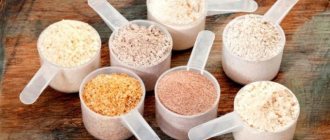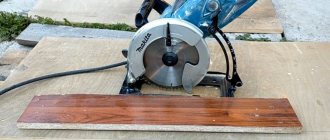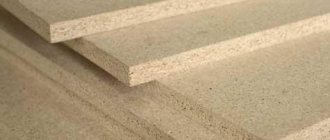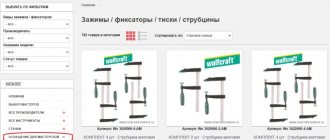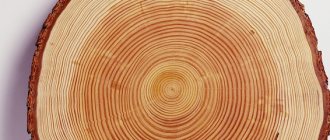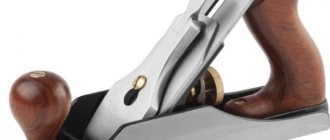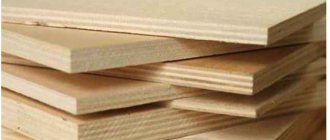Laminated chipboard (LDSP) is the main component for the production of cabinet furniture, which reliably imitates natural wood, But costs many times less.
The cheapness is due to the use of wood waste - shavings.
The production of laminated chipboards has several basic technologies.
Next we will tell you:
- what is laminated chipboard;
- how does the production of laminated chipboard differ from the production of chipboard;
- what documents regulate the quality of laminated chipboards in Russia;
- what equipment is used for lamination;
- how edge tape is made;
- How to laminate chipboard yourself.
What it is?
Laminated chipboard is a regular chipboard , which we talked about here, lined with a decorative coating .
The coating can be either single-color and smooth, or multi-colored or imitating wood texture.
Main characteristics such as:
- bending strength;
- ability to hold a screw;
- density;
- moisture resistance classes;
- formaldehyde emission class;
- flammability
fully correspond to the same characteristics of the source material.
The thickness of the laminated material depends on its purpose. 16 mm thick laminated chipboard is most often used 25–38 mm thick slabs .
Laminated chipboard for cladding walls, floors and ceilings is made from chipboard with a thickness of 8–12 mm .
A laminating layer with a three-dimensional pattern increases the thickness of the chipboard, because such a pattern is created by pressing the base layer , pressing the contours of the pattern onto it.
The outer film only follows the contours of this pattern.
Fibreboard production methods and their differences
There are 4 ways to make fiberboard:
- Wet. Before forming the carpet, a suspension consisting of water and wood fibers is obtained. Binders and other components are not added to the mass. Before pressing, the suspension is thrown onto a mesh so that water can drain down. This creates a mesh pattern on one side of the slab.
- Dry. Wood chopped into fibers is mixed with binding resins. With the dry production method, components can be added to the wood fiber mass to increase the moisture resistance and fire resistance of the material . Due to the low humidity of the carpet, there is no need to use a mesh. Therefore, both sides of the sheets are smooth.
- Semi-dry. This method of producing hardboard is similar to the wet method. But it does not require a suspension - the fibers are moistened after the carpet is formed.
- Wet-dry. This manufacturing method is also similar to the wet one. It also involves the production of a suspension. But the formed carpet is first dried and only then pressed.
The main technologies for the production of fiberboard boards are dry and wet methods . The dry manufacturing method produces a more durable and moisture-resistant material due to the addition of synthetic resins. The wet method allows us to obtain 100% environmentally friendly fiberboard sheets, which are safe to use for finishing residential premises. Semi-dry and wet-dry methods have not become widespread.
How are chipboards made?
To make laminated chipboards, ordinary sanded chipboards are used, so they are produced at a chipboard production plant, connecting a lamination section .
Moreover, 3 technologies are used to cover the source material with a laminating film:
- lamination;
- laminating;
- smooth lamination.
Lamination
When laminating, 1-2 layers of specially prepared paper are glued onto the base , and the first layer - the base - is made as thick as possible so that the design can be pressed into it.
The thickness of the base, depending on the depth of the pattern, can reach 0.5–1 mm, the thickness of the second layer is tenths or even hundredths of a mm.
On top of these layers, another one is laid, made of transparent paper and a mixture of various resins, which, when heated, turn into a durable film that reliably protects the decorative surface.
The base layer is laid on the prepared chipboard surface and pressed down with a hot stamp with a suitable pattern.
The surface temperature of the stamp is 150–220 degrees, due to which the resin that impregnates the base layer is mixed with the resin that glues the chips in the chipboard and the paper becomes an inseparable part of the board .
Then, in the same way, a decorative layer with a suitable pattern and an outer layer are glued, which protects the slab from damage.
At some enterprises, all layers of coating are first connected to each other, then dried and, only after that, attached to the chipboard.
With this technology, the coating is made in the form of a tape. The pattern on it is formed using a cylinder with an installed matrix, similar to the formation of a pattern during laminating.
The difference with laminating is that the tape is attached without glue, heating the resins that impregnate the paper until it melts and mixes with the resin in the chipboard.
Laminating
When laminating, the facing material is first prepared, for which all layers are laid in order and a pattern is printed on them using a cold press .
At the same time, the uncured resin of the various layers is mixed, due to which the coating turns into a wide and long ribbon.
If a cylindrical stamp , then it becomes possible to make ribbons of any length .
Many small enterprises producing laminate with a three-dimensional texture prefer not to spend money on expensive equipment necessary for the production of tape, but to buy ready-made material.
The finished tape is sent to the dryer, then wound into rolls, which are delivered to the laminating area. There, the facing material is cut to size and placed on a slab coated with a special glue, then pressed with a press and heated until the glue is completely polymerized.
Thanks to this technology cladding goes faster , because there is no need to heat each layer of coating separately , so the enterprise can produce more products.
The disadvantage of this technology is that the glued cladding holds much weaker than real lamination.
Smooth lamination
This technology is similar to laminating , but is a full-fledged lamination, because when heated, the resin of the coating and the boards are mixed, forming a single material. In addition, there is no press for creating a pattern .
To create a smooth surface, it is enough to lay 2 layers, the bottom of which will be made of paper , and the top of a special film, which, when heated, forms a durable and transparent coating .
Due to the fact that large chipboard manufacturers are constantly looking for ways to increase production manufacturability and reduce costs, various changes are constantly being made to this process, the essence of which is kept secret by manufacturers. After all, any improvement in the quality of the laminating coating, as well as a reduction in costs, makes their products more competitive.
Production consists of several stages:
- sawdust production;
- sorting and drying of raw materials;
- connecting shavings with glue;
- carpet formation;
- hot pressing of plates;
- cooling;
- grinding and cutting;
- package.
- Receiving chips
For sawdust, any waste lumber is used. Non-industrial wood is freed from bark, cut into meter-long pieces and placed in a pool for hydroprocessing. The shavings in the machines are cut parallel to the wood fibers from half-meter lengths. More than half of the chipboard composition is made up of large chips, from which the middle of three layers is formed. The outer layers consist of finer chips of high quality. The chopped chips are fed into special mills, where they are split into width by hammers and become smoother.
- Drying
Sawdust also comes from woodworking factories into special bins for collecting shavings. To dry, the chips enter the installation via a conveyor, where they are mixed and blown with hot air. Large particles are separated from normal particles and returned to the shredder.
- Forming a carpet from shavings and glue
Dry shavings are dosed into the mixer, and glue - synthetic resin - is also supplied there. To ensure that the glue evenly covers the chips, it is sprayed using compressed air. The glue-coated chips are placed on a vibrating conveyor.
- Pressing and cooling
The carpet is formed using four cold presses:
- the bottom layer of the carpet is formed in the first;
- the second and third press form the second layer of large chips;
- in the fourth press, the third, outer layer of the carpet is formed.
Next, the three-layer carpet is placed on a compacting press, and the thickness of the composite is reduced threefold. The heated and moistened carpet goes under a hot press. The temperature in the chamber is 150 degrees Celsius, and the pressure is 20 kg for every square centimeter of carpet.
Moisture, quickly evaporating under pressure, forms a steam boost. Steam penetrates into each layer of the carpet, reducing its exposure to pressure.
When the pressing process ends, the hot plate is cooled by a stream of cold air. The finished slab is sanded.
Documents regulating quality
The main document regulating the quality and characteristics of laminated chipboards in Russia is GOST R 52078-2003 , which you can find at this link.
There is also an international standard EN 14322:2004 , which is in many ways similar to the Russian one. You can find it here.
These standards differ from those adopted for chipboard only in the requirements for the laminating coating. In all other respects they are completely identical .
In addition, there are various specifications (technical conditions) that are developed by both manufacturers of laminated particle boards and furniture manufacturers. The technical specifications prescribe those requirements that are not included in generally accepted standards or for some reason fall outside them.
For example, the technical specifications may specify non-standard product dimensions , and also indicate the detailed composition of the adhesive , which differs from what the company uses in the production of conventional chipboard.
General overview of the laminated chipboard production market
Furniture production is perhaps the second most profitable after construction.
But currently in Russia the furniture production segment is quite well occupied - a novice entrepreneur will have to make considerable efforts to enter the market. However, many novice entrepreneurs forget that in some cases it is more profitable to produce raw materials rather than process them and produce finished products. This also applies to furniture production, so the production of materials for making furniture is a more promising occupation than the actual production of furniture.
Laminated chipboard or laminated chipboard is currently the most popular material for furniture. The reason for this is the optimal combination of price and quality. In terms of physical and mechanical properties, including moisture resistance, laminated chipboard is, of course, somewhat inferior to wood, but the variety of textures, ease of processing and low cost are its undoubted advantages.
Indeed: some types of wood - for example, oak or beech - require lengthy and costly processing and preparation, which significantly increases their cost, while laminated chipboard “oak” or “beech” with a similar appearance costs an order of magnitude cheaper.
In addition, opening a business for the production of laminated chipboards is accompanied by such factors as a small number (and in some cities and even regions, the complete absence) of competitors and a vast sales market: after all, even if there are no large furniture factories, all products are simply dismantled by small and medium-sized industries , which have a tendency to gradually enlarge, and therefore increase the demand for laminated chipboard.
All of the above points make the production of laminated chipboard one of the most promising and cost-effective compared to many others.
Equipment: plant and its components
In most cases, a multifunctional device called a laminator . Its basis is a powerful press with steam or oil heating of the plate, as well as the ability to install matrices with the required pattern.
The laminator can be large, capable of processing sheets of maximum size, or medium or small. If a large press is installed, then after cooling the laminated sheet goes to a cutting machine, completely similar to that used in the production of chipboards.
In addition, the laminator
can be single- or double-sided , that is, stick the film only on the front side or simultaneously process the front and back planes.
Medium-sized presses are designed for laminating already cut slabs, the size of which complies with the requirements of GOST R 52078-2003 and EN 14322:2004.
The small press is designed for laminating finished parts, for example, entrance and interior doors or furniture elements. Therefore, a company should choose a laminator based on its product range.
In addition, together with a large or medium laminator, a tape laying line is often used, which also performs several functions:
- determines the quality of chipboard surface preparation for further processing;
- lays the tape on the slab and orients it correctly;
- trims off excess tape.
In enterprises where small laminators are installed, this operation is usually performed by a specially trained, highly qualified worker who lays and cuts the tape manually. This is most often done in furniture factories when they have to make parts that for some reason cannot be cut from a whole sheet.
They do the same in large woodworking shops or factories that produce not only furniture, but also various carpentry products .
The laminator can be used not only for lamination, but also for regular gluing, so there is no point in spending money on a special line .
Often, after cooling, medium and small slabs are fed to a cutting machine, which cuts off 1–2 mm of slabs, forming an even edge. This machine is equipped with large-diameter circular saws tipped with hard alloys or diamond-coated.
The slabs are moved along the entire line using belt conveyors and vacuum lifts, and all operations occur automatically .
The cost of equipment depends on many factors, so most enterprises that produce such lines and individual machines announce the price only after the customer provides specific requirements for configuration and performance.
On Aliexpress and other sites you can find individual devices and entire lines with an indication of the approximate cost excluding delivery and installation.
An average single-sided laminator for boards measuring 1220*2440 mm can be purchased for 100–200 thousand US dollars , and a laminating tape supply line 60–120 cm wide will cost 18–25 thousand US dollars .
Financial calculations
The minimum cost of automated equipment of small capacities will be 7 million rubles. Such lines can produce up to 100 sheets per shift. The cost of large lines (up to 1000 sheets/shift) costs up to 15 million.
It is difficult for a beginning businessman to find such initial capital. It is unlikely to be possible without attracting credit funds. To confirm the profitability of the enterprise and the prospects for payback, you need to draw up a detailed business plan.
You can save a little on the main expense item - equipment: purchase it on lease with the option to buy it in the future. Do not overpay for brands when buying European equipment: take cheaper Chinese ones. Recently, its quality is practically not inferior to European, but the cost is lower.
Production facilities take up a lot of space, so you need a room of at least 200 square meters. m - excluding warehouses for raw materials and products.
The number of personnel depends on production capacity.
Start-up capital
The minimum starting capital will be at least 10,500,000 rubles (most likely even more). This amount includes:
- Purchase and installation of main and additional equipment - 10 million (7 million - purchase of main equipment + 3 million - additional and installation).
- Creation of the main inventory – 500,000.
- The cost of registering an enterprise is 50,000.
- Preparing the premises – 300,000.
Monthly expenses
Monthly costs will be about 600,000 rubles. This includes:
- rent;
- salary;
- taxes;
- transport costs;
- payment of utility bills.
How much can you earn
The production machine can produce up to 100 sheets of chipboard per day - 3,000 per month. If all manufactured products are sold at 750 rubles per sheet, the revenue will be 2,250,000 rubles per month. Taking into account the cost of production, which is 450 rubles/sheet, and monthly costs, the net profit is 900,000.
Payback period
With a net monthly income of 900,000 rubles, the payback period is from 1 year. But this is an optimistic scenario. More realistic - one and a half to two years.
Edge tape
When manufacturing laminated chipboards, only the front and back surfaces are laminated, and the edges are left uncoated . edge strips along with them , which are used for self-lamination of the ends.
The color of the tape completely matches the color of the slab, so after sticking the tape, the entire slab becomes one color.
The tape for edging, that is, gluing the edges, is made noticeably thinner than that used for lining chipboards in production. Indeed, in a furniture workshop it is impossible to create such high pressure and most craftsmen make do with an ordinary iron , using it to heat the tape laid on the edge.
How to laminate chipboard yourself?
Laminated chipboard, which can be purchased in stores,
does not always match the color or pattern , so you can cover the slab yourself.
Various types of decorative films that are sold in construction stores are well suited for this.
Films can be self-adhesive or regular .
To apply a self-adhesive film, a thin protective coating is removed from it and placed on a chipboard sheet cleaned of dirt and dust, then rolled with a roller, removing air bubbles.
To apply a regular film, use a special glue recommended by the film manufacturer, then wait 2–5 minutes and carefully apply the film, avoiding the appearance of wrinkles .
Such methods allow you to stick on the chipboard only those designs that are in the store, so you can use the method that was used during the USSR , when laminated chipboard was in great short supply.
A thin layer of primer (PVA diluted with water in a ratio of 5:1) was applied to the chipboard surface cleaned of dust and dirt. Then the desired design was made on sheets of landscape paper and the back side was primed with PVA.
After 2–4 days, when the glue had completely hardened, the sheets with the pattern were laid out on the surface of the chipboard so as to assemble the pattern together. Each sheet was then heated with an iron.
If all the sheets were correctly laid and heated, then after cooling they formed a continuous pattern that completely covered the entire surface of the slab.
However, shifting any of the sheets led to disruption of the design and spoiled the entire picture, so for greater reliability they tried to get not landscape paper, but printing paper, which was larger than the plate in size.
The finished pattern was covered with furniture or parquet varnish in 2–3 layers and a homemade laminate with low coating strength , but with the necessary pattern.
Other cladding methods
Laminating is the same as lamination, but it is easier and faster. The surface of the slab is covered with glue, paper impregnated with resins is laid on it, and leveled with rollers. After this, the slab is sent under a cold or hot press.
The surface of the chipboard is covered with PVC films, but such cladding is more susceptible to mechanical damage. Another type of cladding is natural veneer coating; the process is similar to laminating.
All chipboards seem the same, but they are divided into types and grades, and can be fire- and water-resistant. The slabs are relatively inexpensive, have a smooth surface, are durable: they do not dry out or curl, therefore they are a universal material for furniture production.
Video material “Production of furniture chipboard”:
